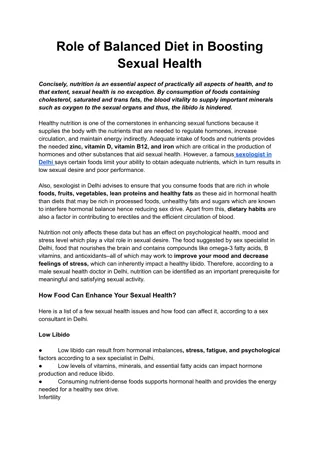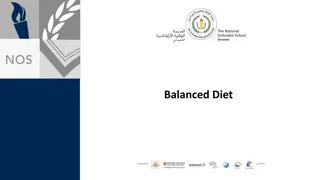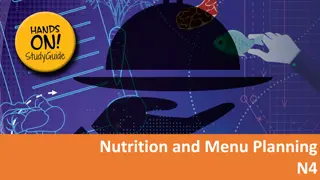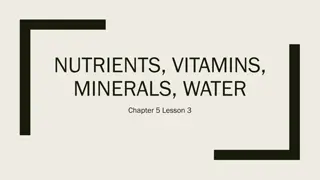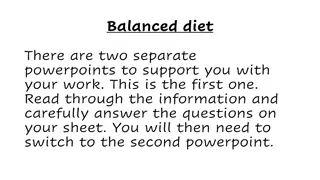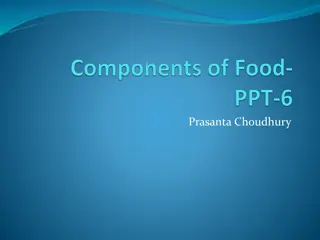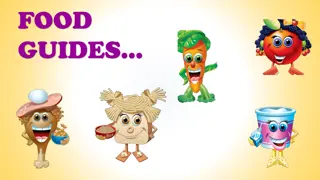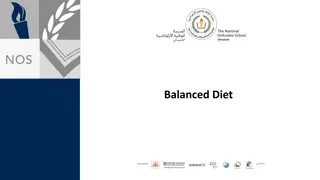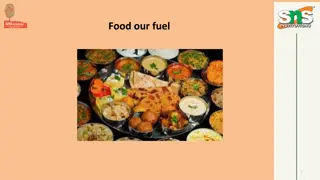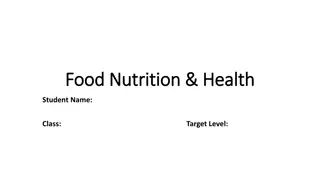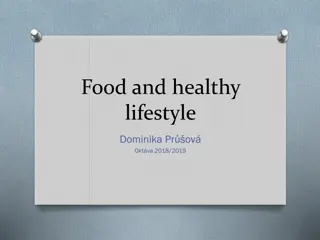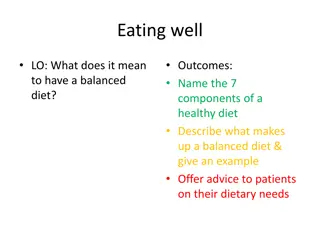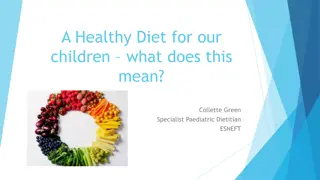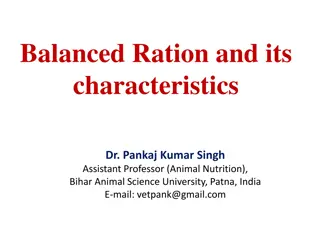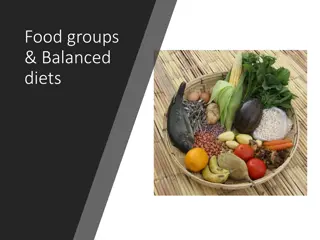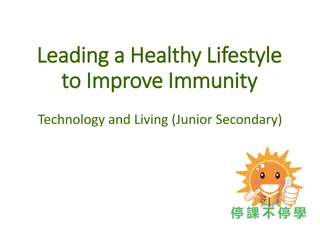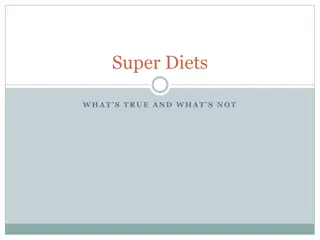Understanding Balanced Diet, Nutrients, and Health Impact
A balanced diet provides essential nutrients for the body's cellular functions and supports growth. Nutrients like proteins, carbohydrates, fats, vitamins, and minerals play vital roles in maintaining health. Imbalance in these nutrients can lead to various health issues such as weight gain, diabetes, and deficiencies. It's important to consume the right amounts of each nutrient for optimal health.
Download Presentation

Please find below an Image/Link to download the presentation.
The content on the website is provided AS IS for your information and personal use only. It may not be sold, licensed, or shared on other websites without obtaining consent from the author. Download presentation by click this link. If you encounter any issues during the download, it is possible that the publisher has removed the file from their server.
E N D
Presentation Transcript
BALANCED DIET AND NUTRIENTS
WHATISBALANCEDDIET??? A balanced diet means getting the right types and amounts of foods and drinks to supply nutrition and energy for maintaining body cells, tissues, and organs, and for supporting normal growth and development.
NUTRIENTS 2 types of nutirents- 1. Major- protein,carbohydrate,fats 2. Micro- minerals- calcium,magnesium,phosphorus,zinc,selenium Vitamins- a,d,e,k,c,b group Water
PROTEINS 1. Helps in tissue and muscle building 2. Boost up immunity 3. Helps to maintain fluid balance 4. Healing Deficiency- muscle wasting, weight gain, poor immunity and low hb. Sources- milk and milk products, soya bean,beans,dals,egg,chicken,fish.
CARBOHYDRATES 1. Energy giving compound necessary for daily activity 2. Necessary for proper working of brain,heart,nervous tissue. 2 types of carbohydrate A. Simple- refined flour, glucose B complex- fibers Role of fiber: helps in weight reduction, proper bowel movement and healthy intestine Sources: wheat,oats,brans,vegetables,whole cereals and pulses, fruits.
WHATHAPPENSIFITISINEXCESS ORLOW?? Excess- weight gain,diabetes mellitus, insulin resistance, CAD Deficiency- constipation,low mental performance,ketoacidosis.
FATS The main function is to give energy Important for transport of vitamins a,d,e,k Covers organs acts as insulators to our vital organs like heart,kidney,liver. Types of fats: saturated and unsaturated. Saturated- solid at room temperature ghee,butter,coconut oil.. Unsaturated-liquid at room temperature, omega 3 fatty acid omega 6 fatty acid good for our health Sources: olive oil,rice bran oil, soyabean oil,groundnut oil,mustard oil Good source of omega 3 fatty acid- almonds,fish,walnuts. Deficency- vitamin deficiency,dry skin,nervous disorders Excess- weight gain,elevated blood lipid levels,CAD
RDAFORMAJORNURTRIENTS Carbohyrates- 65% of total diet Proteins- 0.8gm/kg of body weight Fats 0.5-1 gm /kg
WHATIFOURDAILYDIETLACKALLTHESE NUTRIENTS??? It leads to a condition called Protein energy malnutrition simply called as malnutrition. Cases of cancers has increased two fold. Reason??? Lack of fiber in diet So what's the remedy???? Inclusion of Protein supplements in our diet. Inclusion of high fiber supplements and food in diet.
Macro Minerals Trace Minerals: Potassium Calcium Phosphorous Iodine Sodium Copper Iron Fluorine /Fluoride Zinc
VITAMINS Are complex organic substances Normal growth, maintenance, Your body cannot produce all vitamins you can get those by eating a nutritious diet. Fat-soluble vitamins: carried in fatty parts of foods and dissolve in fats (body stores them in fat.) Water-soluble vitamins: dissolve in water (body does not store them)
FATSOLUBLE VITAMINS This group of vitamins need fat for their absorption. Deficiency of vit D lead to bone disorders Deficiency of vit A leads to night blindness,poor eyesight,skin problems Deficency of vit E leads to skin disease and problems Vit K deficiency leads to poor blood clotting..
ADEK He steals Rikshaw at Night dark sky K - Haemorrhage E - sterility D - Rickets A - Night Blindness C - Scarvy
VITAMIN A Function: Promote good vision, normal growth, and healthy nerve function Sources: Liver, yellow & orange fruits and vegetables, pears, and broccoli Prevents: skin problems and unhealthy hair, poor vision and night blindness TOXICITY can cause liver damage and severe birth defects. Carotene in carrots converts to Vitamin A
NIGHT BLINDNESS nyctalopia: Inability to see clearly in dim light; due to a deficiency of vitamin A or to a retinal disorder.
VITAMIN D Function: Formation of strong Bones & Teeth Sources: Dairy Products, seafood, eggs, mushrooms, cereal, sunshine Prevents: Malabsorption of calcium; Rickets / Osteoporosis TOXICITY = calcium build up / bone spurs
RICKETS A deficiency disease resulting from a lack of Vitamin D or from insufficient exposure to sunlight. Characterized by softening of developing bone, bow legs, malnutrition, and enlargement of the liver and spleen.
VITAMIN E (ALPHA TOCOPHEROL) Function: Antioxidant; slows down aging, promotes healthy skin & hair Sources: Nuts, seeds, green leafy vegetables, avacados, grains (germ) Prevents: Cellular degeneration TOXICITY can cause blurred vision, nausea, diarhea, dizziness, fatigue
VITAMIN K Function: Assists with blood clotting; essential for bone healing and body repair. Source: Dark green, leafy vegetables, cabbage, liver, cauliflower. Prevents: Hemorrhaging No known TOXICITY
VITAMIN C (ASCORBIC ACID) Function: Aids in wound healing, helps promote healthy immune system, forms collagen. Sources: Citrus Fruits, Cantaloupe, strawberries, pineapple, broccoli Prevents: Scurvy TOXICITY = acid sores in soft tissues of mouth
WATERSOLUBLE Vit c defiency leads to scurvy,poor wound healing,anemia,heart problems
SCURVY A lack of (DEFICIENCY) of Vitamin C characterized by weakness, anemia, bruising, inflamed pores, bleeding gums and loose teeth.
B VITAMINS. Vitamin Complex a GROUP of vitamins .. B1 = Thiamine B2 = Riboflavin B3 = Niacin B6 = Pyridoxine B9 = Folacin / Folic Acid B12 = Cobalamin
VITAMIN B1 =THIAMINE Function: Healthy nerve function and muscle tissue, digestive system, energy metabolism. Sources: Milk, grains, poultry, fish, dried beans Prevents: Beriberi No known TOXICITY
BERIBERI Caused by a deficiency of thiamine (vitamin B1) that affects many systems of the body, including the skin, muscles, heart, nerves, and digestive system. . Common in parts of Asia, where white rice is the main food. In the U.S., beriberi is primarily seen in people with chronic alcoholism.
VITAMIN B2 =RIBOFLAVIN Function: Growth, nerve function, digestion, works with protein for maintenance, energy metabolism. Sources: Milk, grains, green vegetables, meat, fish Prevents Premature aging; Cheilosis No known TOXICITY
CHEILOSIS A disorder of the lips marked by scaling and fissures at the corners of the mouth; caused by a lack of (DEFICIENCY) of riboflavin
VITAMIN B3 = NIACIN Function: Promotes healthy skin and tissues, digestion, and nervous system. Sources: Milk, grains, poultry, fish. Prevents: Pellagra No known TOXICITY
PELLAG An inability to absorb Niacin (B3) or the amino acid may cause scaly sores, cellular degeneration, mucous PH imbalance, and mental barriers.
VITAMIN B6 = PYRIDOXINE Function: Healthy brain function, formation of red blood cells, immune system support. Sources: Beans, legumes, nuts/seeds, eggs ,meat/fish. Prevents: Helps fight infection. No known TOXICITY.
VITAMIN B9=FOLACIN (FOLIC ACID / FOLATE) Functions: Age related memory, vision and hearing loss; promotes healthy red blood cells, maintains body enzymes. Sources: beans/ legumes citrus fruit, dark green vegetables, grains, meats, poultry/eggs, liver. Prevents: Neural Tube birth Defects, anemia and Vitiligo.
VITILIGO Skin condition in which there is a loss of brown color (pigment) from areas of skin, resulting in irregular white patches. Caused by lack (DEFICIENCY) of Vitamin B or Folic Acid and other vitamins such a B12, C and copper & zinc.
VITAMIN B12 = COBALAMIN Function: Healthy red blood cell & marrow, nervous system function, strong immune system. Improves mental energy, memory, protects against allergies and toxins (cyanide in cigarettes) Sources: Milk, eggs, liver, dairy products, fish, and shellfish Prevents: Pernicious Anemia, intestinal malabsorption TOXICITY = slight stomach upset
ANEMIA Chronic disease cause by lack of (DEFICIENCY) of Vitamin B12 typified by abnormally large red blood cells. Disturbs the nervous system causing depression and drowsiness.
DEFICIENCYAND SUPPLEMENTS The normal rda for mineral and vitamins are Calcium-1-2g/d Iron-28-30mg.d Vit A-2400-3000 Vit E-10-15 mg.d Vit D-400- 500 Vit K-50-80ug/d Vit C-40mg/d B12-3-2mcg/d Sodium-2-3g/d
WHATIFALLTHESENUTRIENTARELACKING INOURDIET??? Although all the mentioned vitamins are present in our daily diet but some how or the other their absorption is not proper. Reason?????? Lack of vit c might leads to poor absorption of iron. Lack of vit d leads to calcium deficiecy. Some one cannot depend completely upon the food to meet RDA Here supplement play important role. It provides all the necessary amount of nutrients to our body.
DIETARY SUPPLEMENTS -BENEFITS Enhance immune system Antioxidants Reduce risk of CAD, stroke Decrease risk of Cancers Decrease risk of Cataracts,Arthrits,Macular degeneration,Alzeimers Improvements other chronic diseases
WATER Water is your body's most important nutrient, is involved in every bodily function, and makes up 70- 75% of your total body weight. Water helps you to maintain body temperature, metabolize body fat, aids in digestion, lubricates and cushions organs, transports nutrients, flushes toxins from your body. Daily minimum 10-12 glasses of water should be taken..
PHYSICALEXERCISE Daily 30-45 mins of physical exercise should be done or 3-4 hrs per week.. Physical exercise can be of any type- walking,jogging,swimming,aerobics,yoga,cycling.


![READ [PDF] Dash diet Cookbook for beginners: 365 days of simple, healthy, low-s](/thumb/2057/read-pdf-dash-diet-cookbook-for-beginners-365-days-of-simple-healthy-low-s.jpg)

